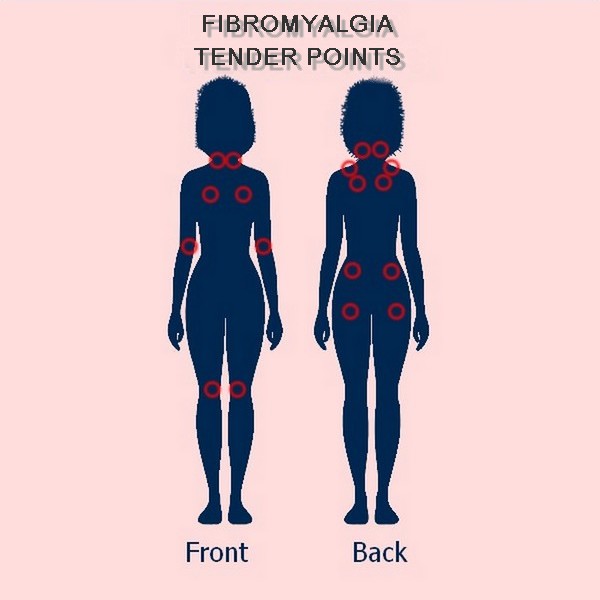Fibromyalgia Pain

Fibromyalgia pain can seriously affect your quality of life. Fibromyalgia itself is described as a condition with the main symptom being widespread pain. And I can concur with this as I have experienced some form of stabbing, throbbing, zapping, burning or aching from the top of my head to the tips of my toes and everything in between.
When discussing Fibromyalgia pain we need to understand what pain is. The pain that people with Fibromyalgia experience is chronic pain. Chronic pain is pain that lasts for more than 3 months despite medication or treatment.
What is Pain?
Why do Fibromyalgia patients suffer pain? The simple answer is no one quite knows.
The central nervous system which includes the brain, spinal cord and nerves carry pain messages from the body to the brain. It is believed by some, including the NHS, that people with Fibromyalgia receive abnormal pain messages.
“One of the main theories is that people with Fibromyalgia have developed changes in the way the central nervous system processes the pain messages carried around the body. This could be the result of changes to chemicals in the nervous system. The central nervous system transmits information all over your body through a network of specialized cells. Changes in the way this system works may explain why fibromyalgia results in constant feelings of, and extreme sensitivity to, pain.”
Many people who get a final diagnosis of Fibromyalgia after several months or years of excruciating, debilitating, incessant and relentless chronic pain do so after numerous doctor visits, undergoing lots of blood tests, x-rays, bone scans, MRI scanning and pain treatments from different specialists. Often a person with Fibromyalgia will be seen by more than one expert in different disciplines - a rheumatologist, neurologist, pain specialist, psychologist etc.
Over a period of about 3 years I, myself saw 5 different GPs, 3 different rheumatologists, 1 endocrinologist and 1 gynecologist all the time suffering intense chronic pain. Only after seeing my third rheumatologist was I given the diagnosis of Fibromyalgia.
And of course Fibromyalgia pain is just one of the many symptoms that people with Fibromyalgia endure. Other ailments including chronic fatigue, depression, brain fog, muscle weakness etc. are endured at the same time as the widespread Fibromyalgia pain.
Types of Fibromyalgia Pain
There are many types of Fibromyalgia pain in different areas of the body. Many people with Fibromyalgia suffer pain bi-laterally (affecting both sides of the body).
Tender Points
Trigger points and Tender points are often confused.
Tender points were used, and are still used by some doctors to diagnose Fibromyalgia. There are a total of 18 specific tender points found in both sides of the body that once pressed produce intense pain in people who have Fibromyalgia.
 Fibromyalgia Tender Points
Fibromyalgia Tender PointsTrigger Points
Myofascial trigger points also known as just trigger points can be found anywhere on the body and when pressure is applied can trigger pain elsewhere. This is also known as referred pain. Trigger points can be likened to knots found in the fascia or connective tissue. Trigger point massage, or Myofascial release massage can alleviate the radiated pain from trigger points.
People with Fibromyalgia, myself included, can have both tender points and trigger points.
Body Aches and Stiffness
Body aches and stiffness tend to affect the larger muscles of people with Fibromyalgia. Aching, heaviness and stiffness can limit mobility. Buttocks, thighs, calves, upper arms, neck and shoulders are mostly affected. This can be due to a painful Fascia (connective tissue) build up.
Burning Pain
Burning sensations particularly in the hands and feet is a common example of Fibromyalgia pain. Some people do report having hot and burning sensations all over their body, as if they had been sun burnt.
For many months I experienced excruciating hand and foot pain. My hands and feet felt as they were on fire. The burning sensation in my feet could only be relieved by plunging them into ice cold water. After much research I believed that my burning hands and feet were due to Vitamin deficiencies including Vitamin B12 and Vitamin B6. I started using supplements and after many months the burning sensation faded.
I still continued to have aching and painful feet and hands but at least the burning had subsided.
Stabbing Pain
Another form of Fibromyalgia pain is stabbing pains. These knife-like pains usually affect the muscles, tendons and connective tissue. They tend to be intense but short lived and do come and go. They seem to come in waves and throb.
Stabbing pains in the chest and upper back are a little different as the pain feels relentless and constantly there. Chest pain in people with Fibromyalgia is usually diagnosed as Costochondritis.
I felt my stabbing pains more acutely in the early mornings and in the evenings.
Shooting Pain
Shooting pains tend to be very intense but fleeting and can be felt anywhere in the body from your head down to your toes. This type of shooting pain is often so intense that you cry out momentarily.
Dull Pain
An aching, gnawing and dull pain is most often one of the first noticeable symptoms of Fibromyalgia. It tends to affect the muscles and connective tissue but can also be felt in the shin bones and sternum.
Electric Shock Zaps
Electric shock like pain or zaps are often felt in the hands and feet. It feels as though you have received a short, sharp electric shock and you react in the same way as if you really had. You cannot help crying out in pain no matter where you are or whom you are with.
Feeling Bruised
Feeling bruised and battered all over is a very common form of Fibromyalgia pain. For me, it felt as though I had run a marathon, rather than taking the few short steps from my bedroom to the bathroom during the night. If I was forced to climb stairs it felt like I had ascended Mount Everest.
Muscle Pain
Widespread muscle pain is perhaps the most complained about Fibromyalgia pain. Any and every muscle can be painful, sore and stiff. The larger muscles in the buttocks, legs, arms and shoulders seem to be the most affected areas.
Magnesium supplements and/or Epsom salts baths can ease the muscle pains.
Joint Pain

Throbbing and aching joints are yet another example of Fibromyalgia pain. At times every single joint in my body throbbed with pain.
Even the small joints in my fingers and toes hurt as well as more major joints such as my ankles, knees, wrists, elbows and shoulders.
Bone Pain
For me bone pain was one of the most excruciating pains I experienced. My ankles felt as if they had been smashed with a hammer. My shins felt as though someone had hit me repeatedly with a metal bar. And my rib pain was unbearable. This bone pain could affect me at any time of the day but was always worse in the evening. The bone pain would reduce me to tears. Sometimes I would have the bone pain for days on end and at other times it would simply disappear for days.
I believe that a lack of Calcium and Vitamin D (Osteomalacia) were the root cause of this particularly form of Fibromyalgia pain. After many months of supplementing with Calcium and Vitamin D my bone pain disappeared.
Nerve Pain
It is believed that nerve pain or neuropathic pain in people with Fibromyalgia is felt acutely despite a lack of nerve damage. The feelings of pain, tingling, pricking or numbness are more pronounced in the arms, wrists and hands and legs, ankles and feet.
For me the nerve pain felt like acid running though my veins in my hands and feet. The pain was nauseating and I would say was one of the worst examples of Fibromyalgia pain I suffered.
Fascia Pain
Before my Fibromyalgia diagnosis I had never heard of fascia which is another name for connective tissues. And it is within the fascia that a lot of pain is felt. Most people may have heard of Plantar Fasciitis which affects the fascia band on the soles of your feet, but may not realise that fascia, which is all over the body, can also be very painful.
On my road to recovery on my Fibromyalgia journey I came to realise just how much pain is contained in the fascia. And finding ways to break down the painful fascia was my goal.
Migraines and Headaches

Migraines and headaches tend to be present in a lot of people who have Fibromyalgia. Light sensitivity and sound sensitivity tend to trigger migraine attacks in some people with Fibromyalgia.
Tension headaches are common too, especially if you also suffer back and neck pain.
Chest Pain (Costochondritis)
Chest pain or Costochondritis is a common Fibromyalgia pain. The
crushing chest pain feels so severe that many people believe that they are
having a heart attack. Time and again people with Fibromyalgia turn up
at Accident and Emergency departments only to be told after extensive
testing that they have Costochondritis. Costochondritis pain is usually
centred on the sternum (chest bone) but can radiate around all the ribs
including around the back ribs. Many women with Fibromyalgia complain of
bra strap discomfort around their back ribs. Costochondritis may be caused by Vitamin D deficiency.
Back, Neck and Shoulder Pain

The back, neck and shoulders are just other regions of Fibromyalgia pain. Lower back pain and also upper back pain can be excruciating.
Many people with Fibromyalgia hold themselves stiff and are constantly in a state of tension. This tension is felt acutely in the upper back, neck and shoulders. A build up painful fascia is the consequence.
Foot Pain (Plantar Fasciitis)
Many people with Fibromyalgia also have Plantar Fasciitis which is a painful foot condition. It usually affects both feet in Fibromyalgia patients. Plantar Fasciitis occurs due to over use, inflammation or a build up of fascia under your foot.
I believe that Plantar Fasciitis is just another example of painful fascia which can be treated by massage or foot exercises.
Hand, Finger and Wrist Pain (Carpal Tunnel Syndrome)

There seems to be a high proportion of people, particularly women who have both Fibromyalgia and Carpal Tunnel Syndrome (CTS). Carpal Tunnel Syndrome in Fibromyalgia sufferers tends to affect both wrists and is thought not to be caused by injury or repetitive strain. Carpal Tunnel Syndrome is thought to be excess pressure on the median nerve in the wrists. It can cause tingling, numbness and excruciating pain in the hands, fingers and wrists.
A similar condition affecting the feet, toes and ankles is called Tarsal Tunnel Syndrome (TTS).
Face Pain, Jaw Pain, Teeth Pain (Temporomandibular Disorder)
Temporomandibular disorder (TMD or TMJ) can cause face pain, jaw pain or teeth pain. A high proportion of women with Fibromylagia also have Temporomandibular disorder.
I was diagnosed with Temporomandibular Disorder after months of horrendous teeth pain and undergoing dental treatment including a root canal filling and an extraction. The source of my pain did not go away after the dental treatment and everyday for 3 months I had horrendous pain. The root cause of my teeth pain was down to teeth clenching and teeth grinding in my sleep, which is known as Nocturnal Bruxism. After wearing a mouth shield for bed and taking Amitriptyline for pain I no longer had teeth pain.
Irritable Bowel Syndrome (IBS)
Irritable bowel syndrome (IBS) can cause a lot of stomach cramps and stomach pain. The pain caused by IBS can also be felt in the back.
Other digestive problems can also cause very painful trapped wind.
Pain Sensitivity
For many Fibromyalgia sufferers pain sensitivity is one of their biggest problems. Being extremely sensitive to pain throughout the body even with slightest of touches can be tortuous and makes everyday life almost unbearable.
Add to this any pain caused by accident, injury or treatment can be amplified in the Fibromyalgia sufferer. For example undergoing dental treatment will feel much more painful to someone with Fibromyalgia than the general population.
In a nutshell, we feel pain more intensely than other people.